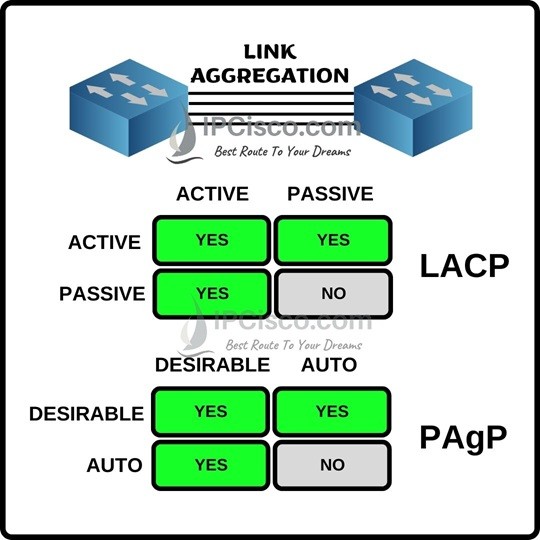- COURSES
- SPECIALS
- BLOG
- MEMBERS
- SHOP
- ABOUT
- ENROLL HERE

Table of Contents
Spanning-Tree blocks redundant links and avoid Layer 2 loops. EtherChannels load balance the traffic between the redundant links and uses the bandwidth more efficient. So, how can we configure etherchannel? To understand more clear, here is a basic Cisco Etherchannel Configuration scenario with Cisco PAgP (Port Aggregation Protocol). Here, you will learn How to Do PAgP Cisco Configuration. You can check PAgP definition on wiki also. We have also done this with LACP before in another Link Aggregation example. You can check it on this Cisco LACP Configuration Example lesson.
In out PAgP Cisco Configuration example, we have two switches that are connected by four cables from their gigabit ethernet ports. We will bundle four of these physical links into one logical link. This is called EtherChannel.
There are two different channel group modes used in PAgP (Port Aggregation Protocol ) and LACP (Link Aggregation Control Protocol). These channel group modes are given below:
PAgP Desirable mode actively attmepts to establish link aggregation while PagP Auto mode waits for the other end.

According to this information, if both ends are configured as Desirable, link aggregation is established. If at least one end is configured with Desirable mode, PAgP link aggregation is again established. But, if both end is configured as Auto, then link aggregation is not established.
Another link aggregation protocol, LACP is use also two different modes. These are Active and Passive. Again Active LACP mode actively attempts to establish link aggregation by sending LACPDUs. But LACP Passive mode waits for the other end.
The similar thing is also true for LACP with different mode names. If both ends are configured as Active, link aggregation is established. If at least one end is configured with Active mode, LACP link aggregation is again established. But, if both end is configured as Passive, then link aggregation is not established.
Here, we will configure PAgP Protocol on Cisco switches for layer 2 EtherChannel. Below you can find Cisco PAgP configuration step by step.
1. First of all, we must create logical interface with “port-channel” command and assign it an ip address. Before assigning an ip address, it is important to change this port to a Layer 3 port by “no switchport” command.
SW1 (config) # interface port-channel 1
SW1 (config-if) # no switchport
SW1 (config-if) # no shutdown
SW1 (config-if) # ip address 192.168.3.1 255.255.255.0
SW1 (config-if) # end
2. Next, physical interfaces must be configured.We must give “no ip address” command to not assign an ip address.Lastly we eill chose the mode.There are various modes for different etherchannel protocols. These protocols are PAgP and LACP. Here PAgP desirable mode is used with “desirable” command.
SW1 (config) # interface range gigabitEthernet 0/1-4
SW1 (config-if-range) # no switchport
SW1 (config-if-range) # no ip address
SW1 (config-if-range) # channel-group 1 mode desirable
SW1 (config-if-range) # end
SW2 will be also configured like above. The only difference in this configuration is used ip address.
SW2 (config) # interface port-channel 1
SW2 (config-if) # no switchport
SW2 (config-if) # no shutdown
SW2 (config-if) # ip address 192.168.3.2 255.255.255.0
SW2 (config-if) # end
SW2 (config) # interface range gigabitEthernet 0/1-4
SW2 (config-if-range) # no switchport
SW2 (config-if-range) # no ip address
SW2 (config-if-range) # channel-group 1 mode desirable
SW2 (config-if-range) # end
For Cisco Layer 2 Ether Channel, there is no need to configure ip address. So only step 2 will be applicable.
Etherchannel Verification
To verify pagp configuration on Cisco switches, we can use the below show commands.
SW1 # show interface fa 1/0 etherchannel
SW1 # show etherchannel 1 port-channel
Etherchannel Load Balancing
Load balancing is not a must in a link aggregation configuration. But here, we can use this command to configure pagp load balancing.
SW1 (config) # port channel load-balance srt-dst-ip
SW1 # show etherchannel load-balance
Leave a Reply